Neuro-Fuzzy Network
The following notebook explains the theory behind Fuzzy Neural Networks. After that you can find a use case example where the model is applied. We create rules and implement them into the network which we build with the prosper_nn package.
Theory
An MLP neural network gets numerical input data, e.g., sensor data and predicts a numerical forcast. The input data is processed inside the network’s hidden layers. What the network does within this process can hardly be interpreted. The neural fuzzy architecture whitens this black box by giving each hidden neuron and its connections a human interpretable verbal meaning. Because of this verbal meaning, we can construct rules for the network to follow. A simple example would be: “If input 1 increases, the output will fall”. If experts have a basic understanding of the relations between input and output of our problem, we can use those rules for initialization of our network. We infuse the domain knowledge into the network. The basic principles of the architectures for regression (left) and classification (right) are shown below:
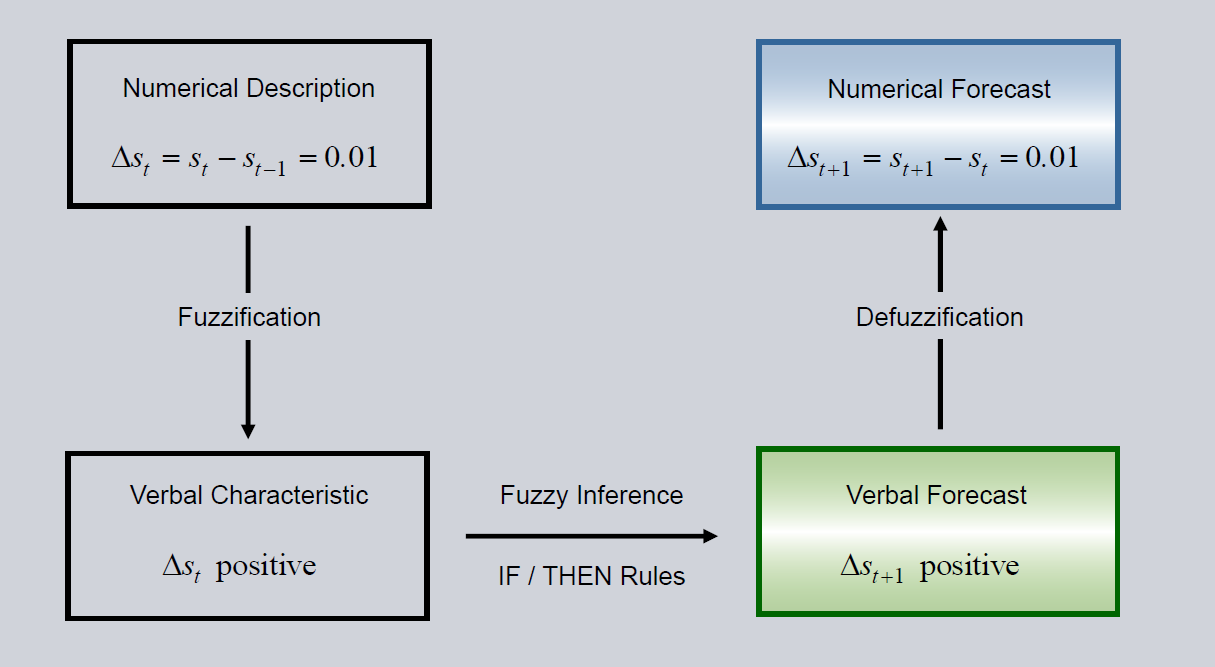
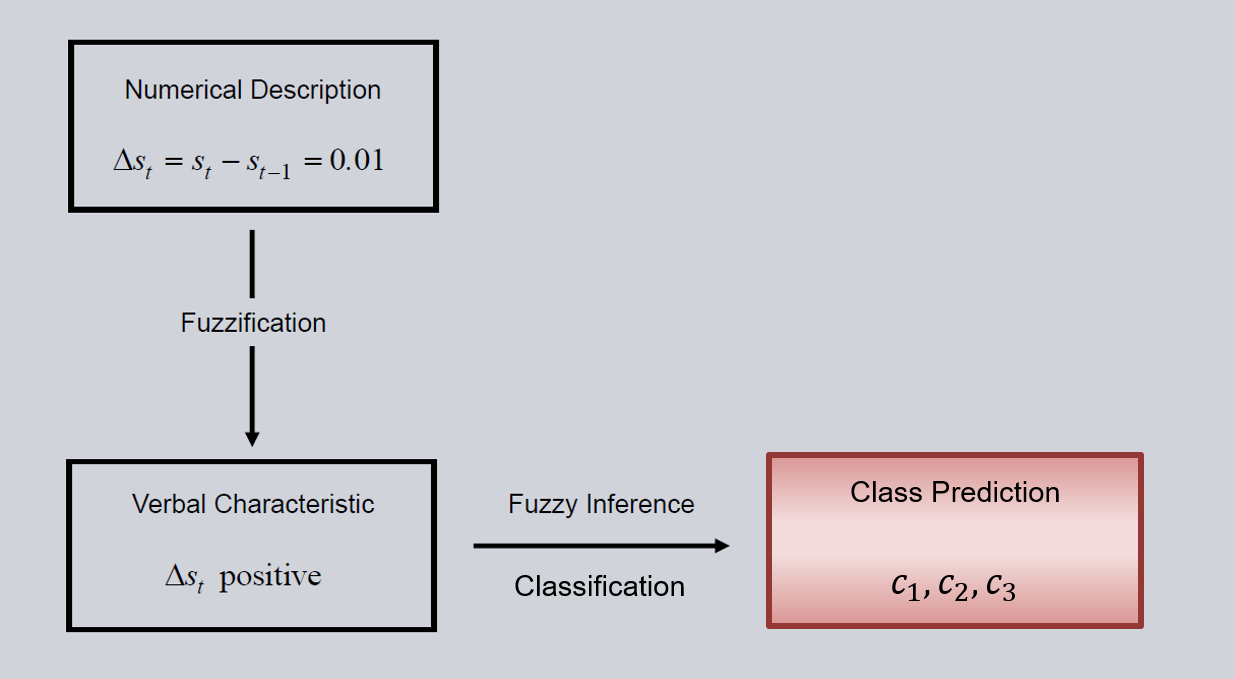
The three steps Fuzzification, Fuzzy-Inference and Defuzzification are described in detail in the following chapters. Regression (left) needs one more step to translate back from verbal to numerical space. Classification (right) happens in the verbal space and therefore no defuzzification is necessary. For Fuzzification membership functions are used. In Fuzzy-Inference the domain knowledge is infused by formulating rules. Defuzzification translates back to the numerical space.
Fuzzification
Fuzzification is the translation of numerical input values into a verbal description. This is achieved by membership functions. They divide the number domain of the input into groups. The functions define the membership of an input to these different groups. Within the package two membership function classes are defined:
gaussian membership function
zero-centered
width of the cone is learned during training
normlog membership function
steepest tangent goes through zero
slope is learned during training
slope can not change its sign
The user can create his or her own membership functions if necessary. By using membership functions, the numerical value of an input is translated to the verbal space. E.g., an input can decrease, increase (corresponding normlog function) or stay constant (gaussian). By changing the parameters of the functions e.g. the width of the gaussian, the model learns what range of inputs corresponds with the membership term e.g. constant (for some measurements a fluctuation of 10 around 0 is
considered stable, for others only a fluctuation of 0.1). 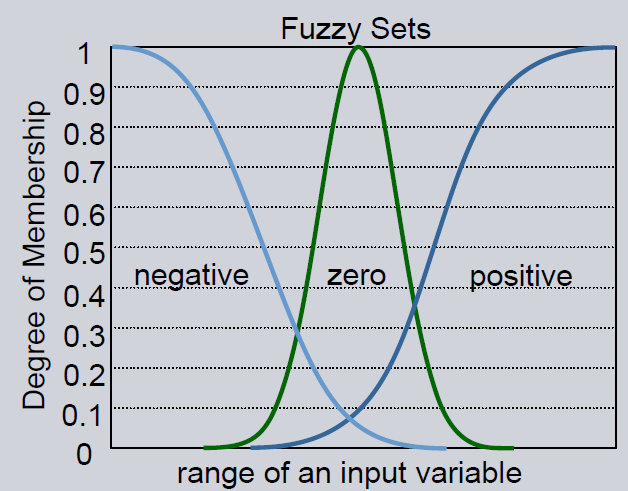
Fuzzy Inference
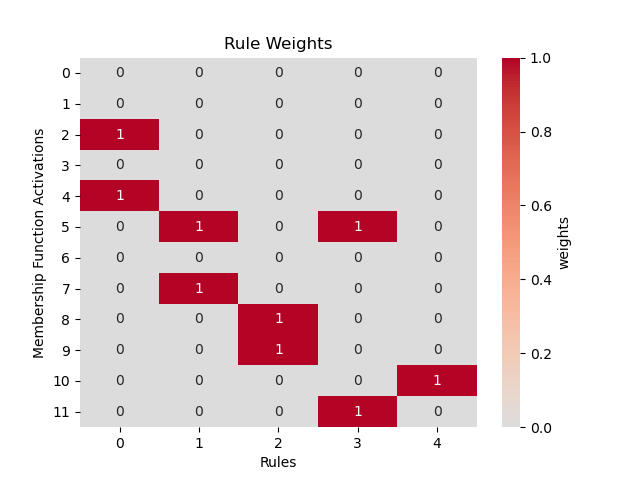
After translating the numerical input into a verbal description, we can apply the domain knowledge to the incoming data. The domain knowledge about a given problem is infused into the network by IF/THEN rules. These rules can be modeled with the edge weights of layers. The relation “IF input_1 increases THEN rule_1 applies” can be modeled by setting the connection weight between node input_1 increases (output node of the corresponding membership function in Fuzzification) and node
rule_1 (condition_fullfillment in Fuzzy-Inference) to 1. All weights that do not represent a rule are set to zero. Example for a conditions matrix is shown on the right (2D input is flattened for visualization).
An AND relation like “IF input_1 increases AND input_2 decreases THEN rule_1 applies” works after the same schema. More than one row is set to 1 in each column (see picture). For an OR relation create a new rule. Instead of: “IF input_1 increases OR input_2 decreases THEN rule_1 applies” we say: “IF input_1 increases THEN rule_1 applies” and “IF input_2 decreases THEN rule_2 applies”.
Knowing how much a condition of a rule is fulfilled, we have to classify based on the rules’ consequences. In the FuzzyInference the meaning of a rule is infused by setting the connection of the consequences matrix. The classification rule “IF rule_1 applies THEN class_1 should be predicted” sets the corresponding node connection to 1. All other connections are set to 0. The generation of the consequences matrix is described in the use case example below. You can create as many
rules as you want.

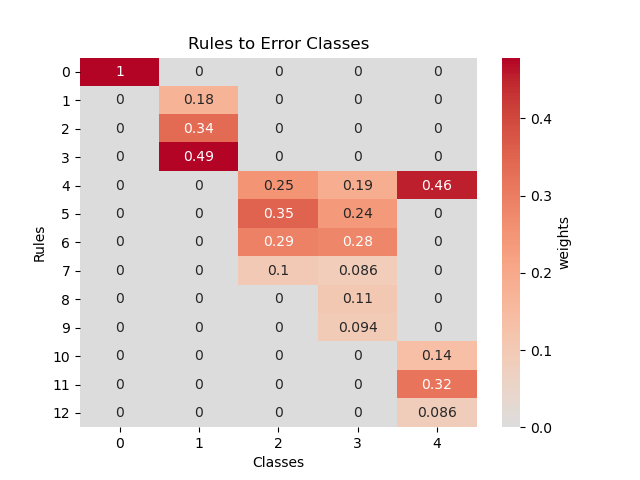
The layer has a constraint so that each column sums high to one. The entries of the matrix can be seen as a belief parameter of how much the network trusts the rule to predict the given class. When visualizing this matrix we can see which rules are strong and which ones are weak. On the left you can see the matrix before and on the right after training.
In regression we classify the three classes raising, stable and falling in this layer. These three classes are the interpretable forecast of the Neuro Fuzzy Network. Depending on the values we see how likely the future bahaviour is.
Defuzzification
In case of regression we have to calculate the numerical value corresponding to the verbal classification. This is done in the Defuzzification step of the network. We can use the Defuzzification layer that applies a Linear layer.
Fuzzy Neural Network Architecture
Overall, the architecture for regression looks like this (for classification the last, blue layer is cut). The Inference matrix \(P\) contains the rule premises. The matrix \(\kappa\) represents a belief value for each rule output, i.e. how much does the network trust the specific rules. The last matrix \(W\) is responsible for Defuzzification.

Neuro Fuzzy Example
First we import all packages that we will need:
[1]:
import sys, os
sys.path.append(os.path.abspath("../../.."))
sys.path.append(os.path.abspath(".."))
sys.path.append(os.path.abspath("."))
[2]:
import torch
import numpy as np
import matplotlib.pyplot as plt
import pandas as pd
from sklearn.model_selection import train_test_split
torch.manual_seed(0)
[2]:
<torch._C.Generator at 0x2131511bb30>
[3]:
# Initialization
# RuleParser
from prosper_nn.models.fuzzy.rule_manager import RuleManager
# Layers
from prosper_nn.models.fuzzy.membership_functions import (
NormlogMembership,
GaussianMembership,
)
from prosper_nn.models.fuzzy.fuzzification import Fuzzification
from prosper_nn.models.fuzzy.fuzzy_inference import FuzzyInference
from prosper_nn.models.fuzzy.defuzzification import Defuzzification
# Utility
from prosper_nn.utils.visualization import plot_heatmap
Data Preparation
We now use Prosper_nn to predict wine quality. For explanation of the data processing see the Regression Notebook.
Second, we load the dataset, split it into a training and test set and create a training and test loader. We use a batchsize of 200.
[4]:
batchsize = 16
[5]:
df = pd.read_csv("data/winequality-red.csv", sep=";").sample(frac=1)
X = torch.tensor(df.drop(columns=["quality"]).values).float()
y = torch.tensor(df["quality"].values).float()
X_train, X_test, y_train, y_test = train_test_split(X, y, test_size=0.33)
# Normalize data
normalize_data = lambda x: (x - x.mean(dim=0)) / x.std(dim=0)
X_train = normalize_data(X_train)
X_test = normalize_data(X_test)
y_train = normalize_data(y_train).reshape(-1, 1)
y_test = normalize_data(y_test).reshape(-1, 1)
# Bring the data in batch format
X_train = X_train[: -(X_train.shape[0] % batchsize)]
y_train = y_train[: -(y_train.shape[0] % batchsize)]
X_train = X_train.reshape(int(X_train.shape[0] / batchsize), batchsize, -1)
y_train = y_train.reshape(int(y_train.shape[0] / batchsize), batchsize, -1)
Initialization
Rule Creation
If you want to infuse domain knowledge in form of rules into the network, you have to create the corresponding weight matrices for the FuzzyInference layer. In the following, we propose a method for the matrix creation, but you can create those matrices however you want if your framework does not suite you.
JSON file
Rules are in a language domain. “IF abc THEN xyz”. We want to store the rules in this domain to keep the ease of understanding them. We use a JSON file to store the rules and use a parser which creates the matrices from the JSON file. The file has four entries:
"rules", here the conditions of theFuzzyInferenceare defined in an understandable form."classification_rules", here it is defined which rule results in which class (consequence)."member_activations", here the numerical translation of the member activations are stored."input_names", stores at what position in the network the corresponding parameter is put in.
For our dataset we created the demonstrator_rules.json file whose content is shown below. Under "rules" 4 dummy entries are listed. We create a rule we think will influence high quality, one for low quality, one where two conditions have to be fullfilled and a complex rule with five conditions. Within the individual rules we define how each input must behave in order for the rule to apply. In the "classification_rule" entry we define what rules result in which of our 3 error classes
(low, average, high). In "input_names" the names of the inputs are saved. The dictionary “member_activations” stores what the verbal parameters of the rules mean numerically.
All JSON code snippets together form the demonstrator_rules.json file.
Under "rules" you define the inference. The naming of the individual rules is up to you. The inputs’ names must match the ones defined in "input_names". The following rule and_rule should be read like this: “and_rule applies IF citric_acid is average AND chlorids is low”. The other inputs have no influence on and_rule.
[6]:
{
"rules": {
"high_quality": {"free_sulfur_dioxide": "high"},
"low_quality": {"fixed_acidity": "low"},
"and_rule": {"citric_acid": "average", "chlorides": "low"},
"complex_rule": {
"fixed_acidity": "high",
"chlorides": "low",
"density": "average",
"citric_acid": "average",
"residual_sugar": "low",
},
},
}
What each rule means is defined in “classification_rules”. In this demo: “IF 2_E1_r1 THEN output at index [1]”
[7]:
{
"classification_rules": {
"high_quality": [2],
"low_quality": [2],
"and_rule": [1],
"complex_rule": [1],
},
}
It is important to know in which order the inputs are fed to the network. The order is defined in "input_names". Each name is assigned at the index at which it is put into the network. The names can also be passed to the Fuzzification for a better overview during debugging (see documentation Fuzzification).
[8]:
{
"input_names": {
"fixed_acidity": 0,
"volatile_acidity": 1,
"citric_acid": 2,
"residual_sugar": 3,
"chlorides": 4,
"free_sulfur_dioxide": 5,
"total_sulfur_dioxide": 6,
"density": 7,
"pH": 8,
"sulphates": 9,
"alcohol": 10
},
};
The meaning of the rule terms e.g. "high", "low", "average", are stored in "member_activations". Depending on the used membership functions you have to adjust this dictionary. The order of the membership functions in the member_functions dictionary of Fuzzification is important. Depending on the meaning of the membership functions, you can create the numerical description of corresponding relation.
[9]:
{
"member_activations": {
"high": [0, 0, 1],
"low": [1, 0, 0],
"average": [0, 1, 0],
"high_low": [1, 0, 1],
"high_average": [0, 1, 1],
"low_average": [1, 1, 0],
"none": [0, 0, 0],
}
}
This is the JSON file for the following membership functions:
[10]:
membership_fcts = {
"decrease": NormlogMembership(negative=True),
"constant": GaussianMembership(),
"increase": NormlogMembership(),
}
Parser
The class RuleManager can be used to parse the JSON file and create the rule_matrix and the classification_matrix. The matrices are created when initializing a new RuleManager object and can be used by an attribute call. The class takes the path to the JSON file as an initialization parameter as well as the matrices’ shapes. We will use the RuleManager in the Initialization part to parse the JSON file.
The data has eleven inputs and 3 different classes. We defined 4 rules in the demonstrator_rules.json file. We use three membership functions (increase, stable, decrease). The shape of the rule_matrix is defined by those parameters. They have to be passed to the RuleManager in order to parse the JSON rules correctly.
[11]:
n_features_input = 11
n_output_classes = 3
n_rules = 4
n_membership_fcts = 3
n_epochs = 20
rule_manager = RuleManager(
path="data/demonstrator_rules.json",
rule_matrix_shape=(n_rules, n_features_input, n_membership_fcts),
classification_matrix_shape=(n_rules, n_output_classes),
)
Membership Function Usage
For fuzzification use the Fuzzification class. It applies a set of membership functions to each input. The layer has a 2D output tensor of shape=(n_features_inputs, n_memberships_fcts). For each input the membership to each function of the set is calculated. This set is a python dictionary containing a custom name for each membership function as keys and the membership functions themselves. The Fuzzification below has three membership functions. It will have n_input = 11 input
features and 11*3 = 33 output features of shape=(11, 3).
[12]:
membership_fcts = {
"decrease": NormlogMembership(negative=True),
"constant": GaussianMembership(),
"increase": NormlogMembership(),
}
fuzzification = Fuzzification(
n_features_input=n_features_input, membership_fcts=membership_fcts
)
FuzzyInference Usage
For Fuzzy-Inference use the FuzzyInference class. It takes a 2D tensor as an input and outputs a 1D tensor. This fits since it follows the Fuzzification, which outputs a 2D tensor by default. As input parameters the FuzzyInference needs the number of inputs of the data set n_features_input = 11, the number of rules n_rules = 4, the number of membership functions (n_membership_fcts) used in the previous Fuzzification and the number of output classes
n_output_classes. The layer requires an optional rule_matrix parameter if rules should be used. Here, we use the rule_matrix of the previously created rule_manager. We set the parameter learn_conditions of the FuzzyInference to True and prune_weights to False, so all weights can change. If prune_weights is set to True, only the rule weights can change; all other stay zero. If learn_conditions is set to False, no weights change. Similarly, we
set the classification_matrix from the rule_manager.
[13]:
fuzzy_inference = FuzzyInference(
n_features_input=n_features_input,
n_rules=n_rules,
n_output_classes=n_output_classes,
n_membership_fcts=n_membership_fcts,
rule_matrix=rule_manager.rule_matrix,
prune_weights=False,
learn_conditions=True,
classification_matrix=rule_manager.classification_matrix,
)
Defuzzification Usage
For the Defuzzification in a regression task we use the Defuzzification class. As parameters this layer takes the number of classes n_output_classes and the number of outputs n_features_output. If we are in a classification task this layer is not needed. The consequence classes will directly be used as classification output.
[14]:
defuzzification = Defuzzification(n_output_classes)
Now we can create our Fuzzy Neural Network by setting the layers in sequence.
[15]:
fuzzy = torch.nn.Sequential(fuzzification, fuzzy_inference, defuzzification)
fuzzy = fuzzy.double()
Training Loop
Now we can set our training parameters in the optimizer and the loss function.
[16]:
optimizer = torch.optim.Adam(fuzzy.parameters())
loss_function = torch.nn.MSELoss()
and write the training loop:
[17]:
losses = []
test_losses = []
for t in range(n_epochs):
for X_batch, y_batch in zip(X_train, y_train):
X_batch = X_batch.type(torch.DoubleTensor)
y_batch = y_batch.type(torch.DoubleTensor)
predictions = fuzzy(X_batch)
optimizer.zero_grad()
loss = loss_function(predictions, y_batch)
loss.backward()
optimizer.step()
losses.append(loss.item())
# test set
for X_test_batch, y_test_batch in zip(X_train, y_train):
predictions = fuzzy(X_test_batch)
test_loss = loss_function(predictions, y_test_batch)
test_losses.append(test_loss.item())
[18]:
plt.plot(range(n_epochs), losses, test_losses)
plt.title("Losses during training")
plt.legend(['Train loss', 'Test loss'])
plt.xlabel("Epoch")
plt.ylabel("MSE")
plt.show()
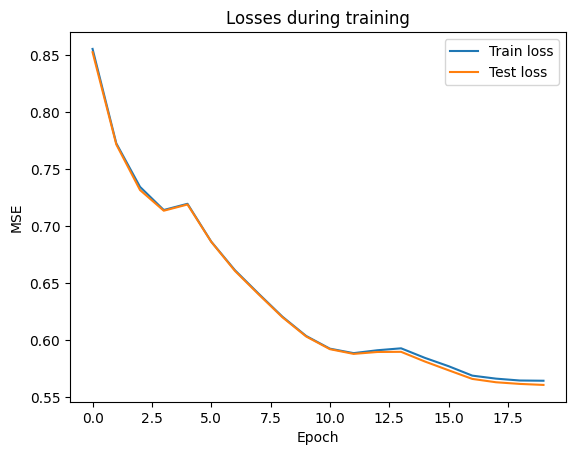
Evaluation
For Fuzzy networks two weight matrices are of interest: The condition matrix and the consequence matrix. Both have prior knowledge infused into them. By visualizing those weights, we can gain knowledge about our problem and maybe change some rules and relations.
Normally, the rule matrix should not change or only alter the one-initialized weights. By turning off pruning and allowing all weights to be trained (prune_weights=False, learn_conditions=True), we can check if our predefined rules are good or bad.
[23]:
original_rule_matrix = np.reshape(
rule_manager.rule_matrix, (n_rules, n_features_input * n_membership_fcts)
).T
plot_heatmap(
original_rule_matrix,
xlabel="Rules",
ylabel="Member Outputs",
title="Original Rule Matrix",
annot=True,
fmt=".2g",
center=0.0,
figsize=(10, 10),
)
trained_rule_matrix = np.reshape(
fuzzy[1].conditions.weight.detach().numpy(),
(n_rules, n_features_input * n_membership_fcts),
).T
plot_heatmap(
trained_rule_matrix,
xlabel="Rules",
ylabel="Member Outputs",
title="Rule Matrix",
annot=True,
fmt=".2g",
center=0.0,
figsize=(10, 10),
)
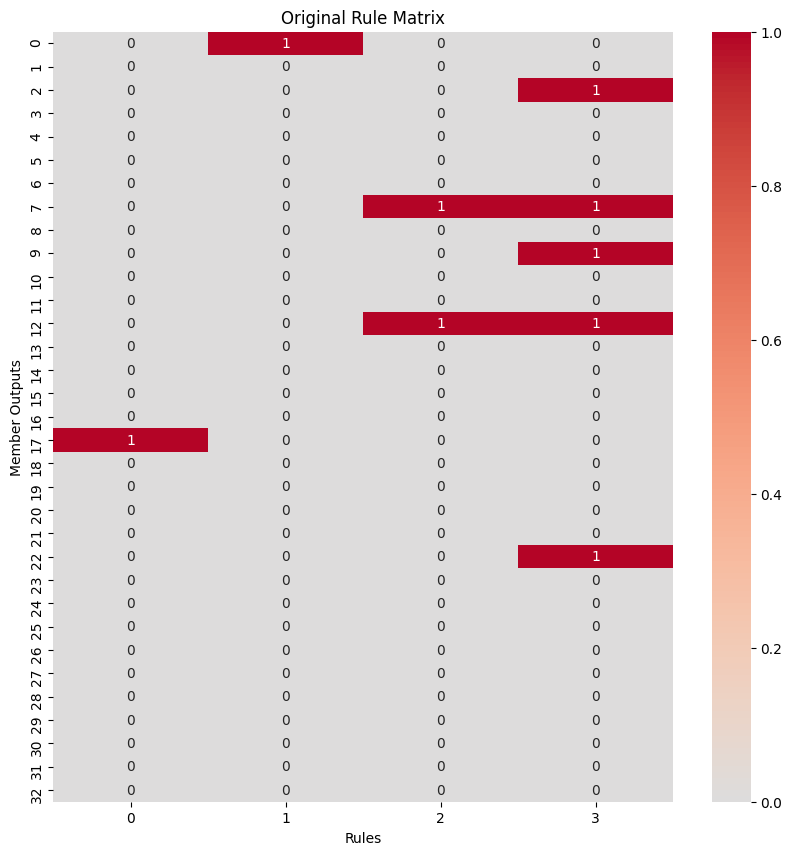
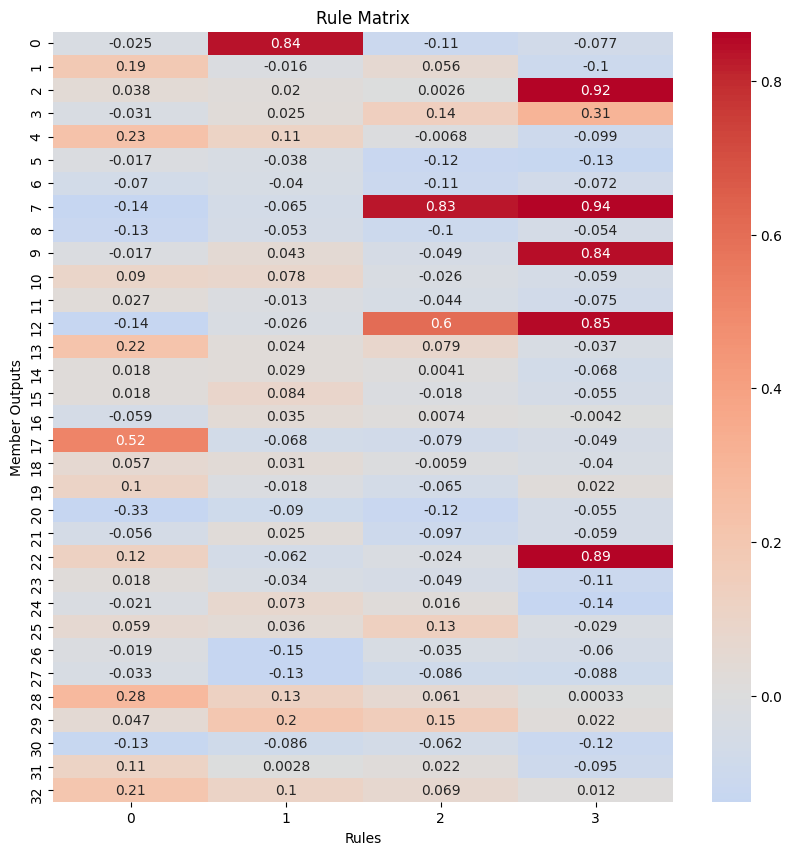
A good rule will keep the already high weights high or even increase them and lower all other, zero initialized weights. This would only strengthen the relation this rule already implied. The second rule is an example. If on the other hand a rule is changing very much, hence loosing its original meaning, it probably is worth rechecking that rule, altering it or even discarding it all together. The first rule is an example for that. A similar approach can be taken when pruning the weights but
allowing the remaining ones to change (prune_weights=True, learn_conditions=True). Here weak and strong rules can be discovered too.
The consequences matrix allows us to see which rules the network finds useful for classifying each class. Each column sums up to one. The entries of the matrix say how much the network trusts the rule for the classification of the column’s class.
[24]:
belief_matrix = fuzzy[1].consequences.weight.detach().numpy().T
plot_heatmap(
belief_matrix, xlabel="Classes", ylabel="Rules", title="Belief Matrix", center=0.0
)
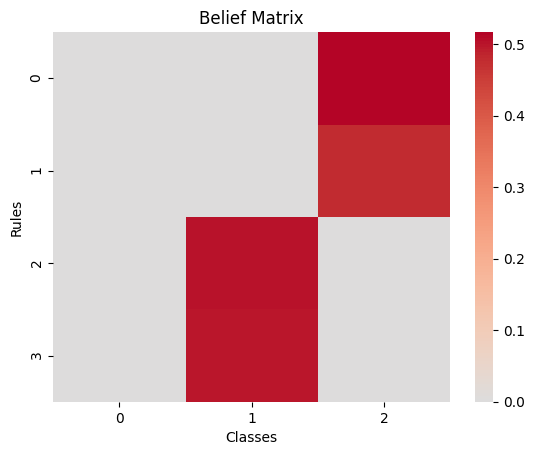
Here again weak rules can be found. In contrast to before, if a rule is weak in this matrix, it might be correct but does not contribute much for classifying the classes.